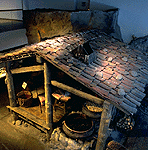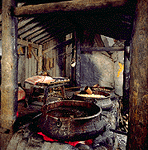Canada Hall
 A Whaling Station
A Whaling Station
The largest of the Basque whaling stations was situated at Red Bay, where, in 1978, underwater archaeologists discovered three sixteenth-century Basque galleons. One of the exhibits in the Canada Hall is a reconstruction of the stern of one of these ships, believed to be the San Juan. According to archival records in Spain, the San Juan sank in 1545 at Terra Nova, during a fall storm. It was carrying a full load of over 1,000 barrels of whale oil, each of which had a capacity of about 200 litres. Although part of the cargo was recovered before the ship sank, the loss of revenue would have been approximately 2.5 million dollars in today's Canadian currency.
 Upon their arrival in the spring, the crews repaired the
whaling stations that had been damaged by winter storms. The
search for whales began by watching from shore. The Atlantic right whales
and bowhead
whales were slow-moving and easy to see on the
ocean's surface. These whales were favoured because they floated
when killed, which greatly facilitated the task of towing them
back to shore.
Upon their arrival in the spring, the crews repaired the
whaling stations that had been damaged by winter storms. The
search for whales began by watching from shore. The Atlantic right whales
and bowhead
whales were slow-moving and easy to see on the
ocean's surface. These whales were favoured because they floated
when killed, which greatly facilitated the task of towing them
back to shore.

Whaling involved risk and violence for both hunters and prey. When
lookouts on shore sighted whales, two or more boats were launched. Each
carried a harpooner, a steersman and four or five oarsmen. The crew
rowed alongside the whales, then the harpooner heaved his weapon. Floats
attached to the harpoon line slowed the whale's attempts to escape. The
animal was struck repeatedly with harpoons, lances and louchets before it
died wallowing in a red sea.
Once the whales were brought to shore, the blubber was rendered into oil at the tryworks. Men worked day and night flensing the blubber, chopping it into cubes and melting it down in large copper cauldrons. The boiling oil was cooled before being transferred into barrels and loaded onto the ships.



Although this was extremely demanding and potentially dangerous work, it was very lucrative because whale oil was a valuable commodity in Europe. Besides being an all-purpose lubricant, it was used for making candles, soap, paint, varnish, lighting fuel, cooking oil, and medicinal substances. A single barrel of oil could be sold for the equivalent of $5,000 in today's currency.
 Ordinary seamen probably shared bowls and drinking jugs. The men
picked up food with their fingers or knives. Crews consumed local
birds, eggs, fish, animals and berries, as well as the ships'
provisions and the men's own supplies. Whalers made crude shelters
on shore, using rocks, timber, sod, whale vertebrae, baleen and
canvas. The men brought little with them except for sleeping mats and
chests containing clothing and personal items.
Ordinary seamen probably shared bowls and drinking jugs. The men
picked up food with their fingers or knives. Crews consumed local
birds, eggs, fish, animals and berries, as well as the ships'
provisions and the men's own supplies. Whalers made crude shelters
on shore, using rocks, timber, sod, whale vertebrae, baleen and
canvas. The men brought little with them except for sleeping mats and
chests containing clothing and personal items.
Whaling was a very intensive and productive industry. It is estimated that between 1545 and 1585 over 17,600 whales were killed and processed at whaling stations in southern Labrador. However, Basque whaling in the New World ended by the late sixteenth century due to the depletion of the stock and the need for ships and crews for the Spanish Armada (1588).

